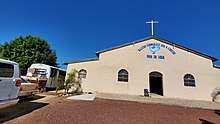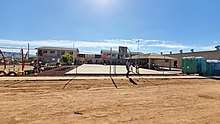San Telmo, Baja California
San Telmo is a village in Baja California, Mexico.[1] It is a small village situated along the Pacific border of Mexico's Baja California Peninsula. It is registered within the Licenciado Gustavo Días Ordaz municipality, which is a part of the massive Ensenada municipality of the State of Baja California.[2] It is also a part of a region in Baja California called Heroes de Chapultepec —2,142 kilometres (1,331 mi) northwest of Mexico City, the country's capital city.[3] San Telmo is also known as El Bramadero.[4]

San Telmo | |
|---|---|
| Coordinates: 30.9692°N 116.0913°W | |
| Country | |
| State | |
| Population (2005) | |
| • Total | 29 |
| Time zone | UTC−8 (PST) |
| • Summer (DST) | UTC−7 (PDT) |
There are many surrounding cities that are nearby San Telmo such as San Diego and Ensenada, which are 275.4 kilometres (171.1 mi) and 143.9 kilometres (89.4 mi) from San Telmo, respectively.[5] In addition, it is located about 244.6 kilometres (152.0 mi) from Tijuana, 60.1 kilometres (37.3 mi) from San Quintin, and 26.1 kilometres (16.2 mi) from Camalú. Although it is noticeably south of San Diego, the temperature differs greatly from day to night, ranging from 37 to 7 °C (99 to 45 °F).[6]
History and Significant Events
Labor Protest of 2015
Background Information
On March 17, 2015, a strike rose in the state of Ensenada. Approximately 300,000 people work in the coastal region of San Quintín and San Telmo —one of Mexico's leading export regions for crops such as strawberries, tomatoes, and cucumbers.[7] During the protest, field laborers demanded a higher salary and government benefits such as social security and insurance. Before the protest, workers earned around 110 pesos per day with 10 hours of labor.[8] Protestors raised up their current issues during the meeting with the representatives but granted negotiations with the Consejo Agricola de Baja California soon ended when Alberto Munoz, the representative of agribusinesses, did not return to the meeting. As a response, Fidel Sanchez, a spokesman for the Alliance of national (State and Municipal Organizations for Social Justice) —a partnership of indigenous groups representing laborers —told the agribusinesses representatives that if Munoz does not present himself, he and the protesters cannot be held accountable for what happens.[8] United Farm Workers of America (UFW) from the United States decided to support Mexican farm laborers by circulating an online petition that was directed toward major companies such as Driscoll's.[9]
Events
When negotiations were not met, protestors closed down Transpeninsular Highway —the main highway that is used to export markets in California. In order to maintain stability, a myriad of soldiers and local, state, and municipal police were sent to secure the area which was nearby small cities of Mexico such as San Telmo, Camalú, and San Quintín. However, the protesters later decided to lift the roadblocks off the highway which deescalated the tension.[8] Although some events ended in peace, some did not. One of the riot was fueled by the absence of Munoz during the negotiations meeting that was mentioned above. The ruthless combat between the protestors and the police left tens of people injured and dead from tear gas and rubber bullets. According to Justino Herera, the farmworker leader, 45 were injured and six were transported to the hospital from police attack.[8]
Causes
This conflict has its roots in the North American Free Trade Agreement (NAFTA), an agreement that allowed tradeoff of Mexican farmers. Introducing Mexico's internal markets to an enormous number of U.S. and Canadian markets effected Mexican grain farmers and their families and led them to be displaced because they could not compete with the imported grains. These displaced farmers were promised jobs in foreign manufacturing concerns, which were to enter Mexico —appealed by the low wages. In addition, Mexican fruits and vegetables were to be exported to U.S. markets, offering another source of incomes for the farmers.
However, displaced farmers with jobs that were created by foreign corporations did not pay well. This broken promise stimulated Mexican farmers to migrate to the U.S. But because U.S. did not and does not provide immigration visas to this population, most of them stepped into the country as undocumented workers. Prosperity and wealth gained from Mexican products went to rich landowners and growers instead of to displaced "campesinos."
Effect on San Telmo
Due to this violent protest, gas stations, stores, and schools, including El Porvenir Primary School(below), were closed down. Because workers were not present, harvesting paused in the greenhouses.[7]
The strike also impacted most agribusinesses' exports but they returned to full production after a few days with little harm. Although their requests were not met, many farmers returned to work. However demands such as access to social security, combating child labor, establishing greater security measures, housing for workers, and ensuring labor rights were followed through.[10]
Education
El Porvenir Primary School

El Porvenir Primary School is a government certified primary school located in Heroés De Chapultec (San Telmo Community), a small rural community in Baja California, Mexico. In 2009, El Porvenir Primary School opened with a vision to raise up community leaders who will impact the larger community, by a nonprofit organization by the name of “4 Christ Mission.” Starting with 60 students, El Porvenir has been growing from then, serving 120 students in grades 1-6 as of today. Teachers of El Porvenir are certified Mexican teachers with credible teaching backgrounds and are local community members in which they serve. Every summer, a team of 30-40 college students and young adults gather together to offer an English teaching program, which includes classes such as arts and crafts, dance, religious education, and community service in order to provide a broad spectrum of education for El Porvenir students. Because of opening of El Porvenir Secondary School, the organization 4 Christ Mission has decided to merge the school together. The original Primary School is being planned to build El Porvenir High School. [11]
Religion
San Telmo Church (Ven a Cristo Iglesia)

Established in 2001, San Telmo Church is known as Ven a Cristo Iglesia in San Telmo. For over ten years, Ven a Cristo has been visited by multiple church groups and individuals from Mexican community churches and the United States. Doctors and dentists also have made frequent trips to San Telmo to deliver basic medical care for local church and community members. Other church groups, youth, and individuals have spent days, weeks, and months at the mission center to share the Gospel, give out food and other basic needs to families in San Telmo. During the summer, over 400 youths from California, Illinois, Pennsylvania, New York and more, gather together to pray for and serve the local community for a week. All 400 people eat, sleep, and serve at Ven a Cristo Iglesia and local churches around San Telmo to serve the community with the vision and a purpose to transform the local community with the love of Christ.[12]
References
- Froylan Tiscareño (31 May 2013). Baja California Adventures. Xlibris Corporation. pp. 410–. ISBN 978-1-4836-4193-5.
- "Licenciado Gustavo DÃaz Ordaz". Retrieved October 13, 2015.
- "Heroes De Chapultepec Destination Guide (Baja California, Mexico) - Trip-Suggest". Retrieved October 13, 2015.
- "El Bramadero (San Telmo) (Baja California)". Retrieved October 13, 2015.
- "San Telmo Destination Guide (Baja California, Mexico) - Trip-Suggest". Retrieved October 13, 2015.
- "San Telmo Weekend Weather - AccuWeather Forecast for Baja California Mexico". Retrieved October 13, 2015.
- "Farmworkers in Baja California Protest Low Pay, Poor Conditions". Retrieved October 15, 2015.
- "Tensions High amid Crippling Protests by Farmworkers in Baja". Retrieved October 15, 2015.
- "U.S. Call to Support Striking Farmworkers in Baja California, Mexico". Retrieved October 15, 2015.
- "Mexican Farmworkers Achieve Major Gains in San Quintin Protests". Retrieved October 15, 2015.
- "Education Transforms, Empowers, and Inspires". Retrieved October 15, 2015.
- "El Porvenir Primaria, Mexico". Retrieved October 15, 2015.
